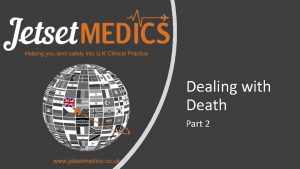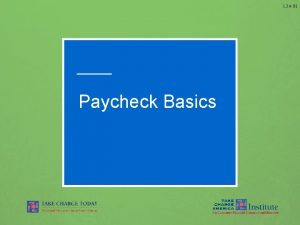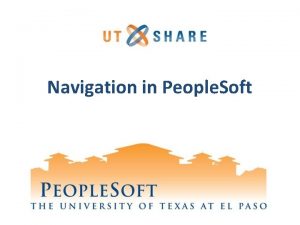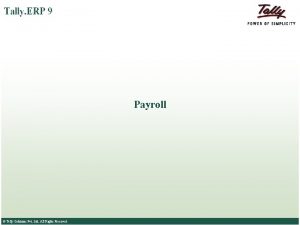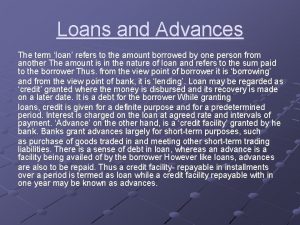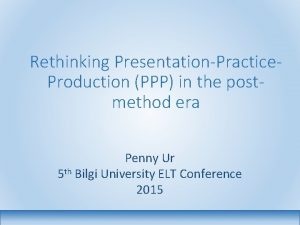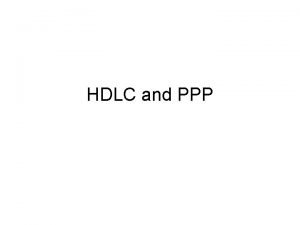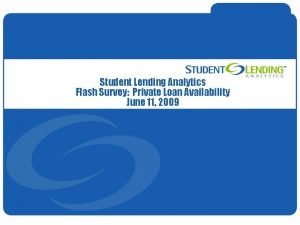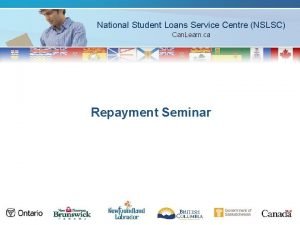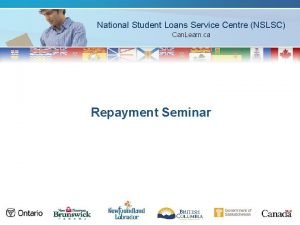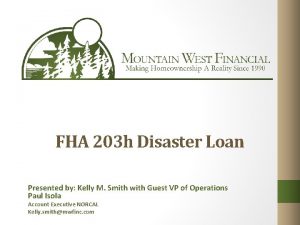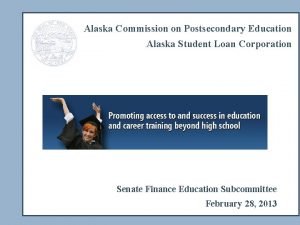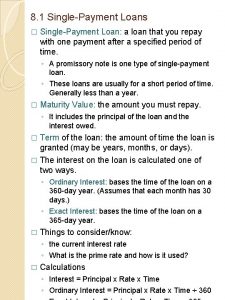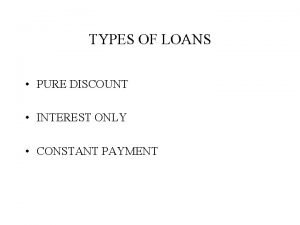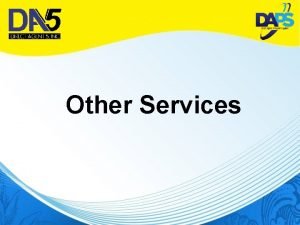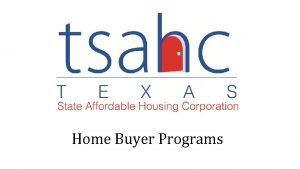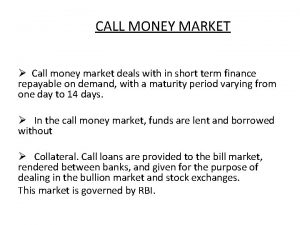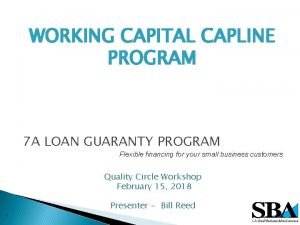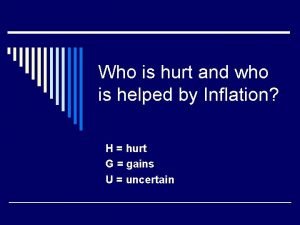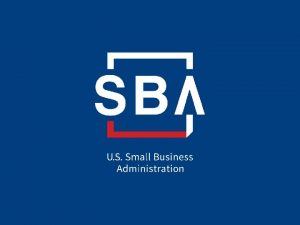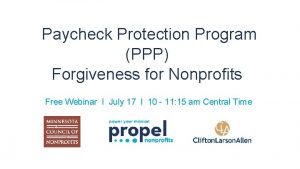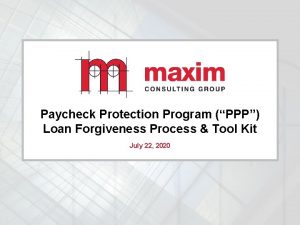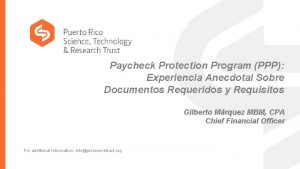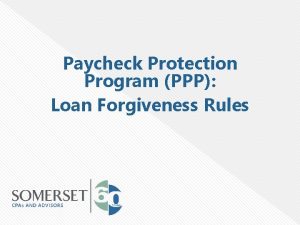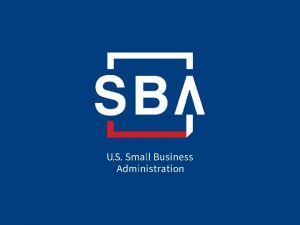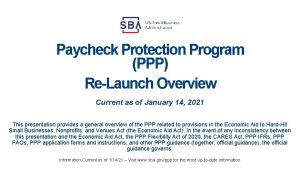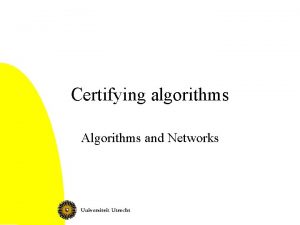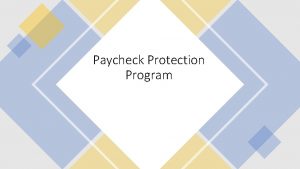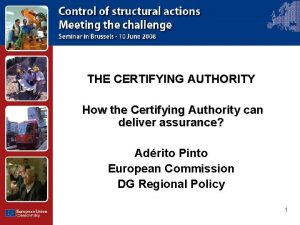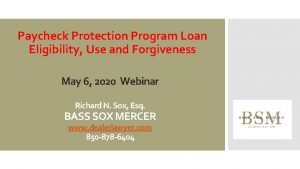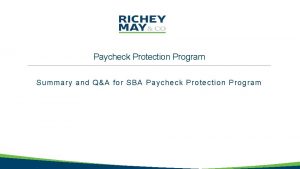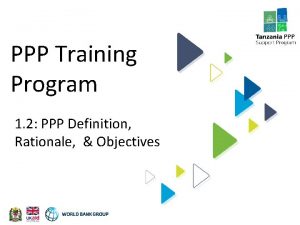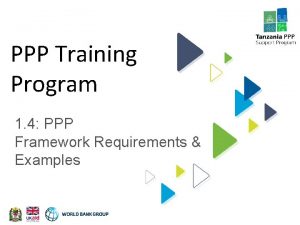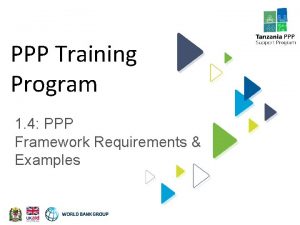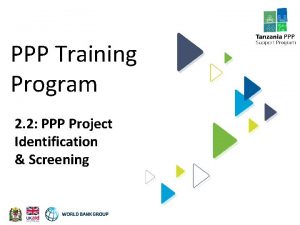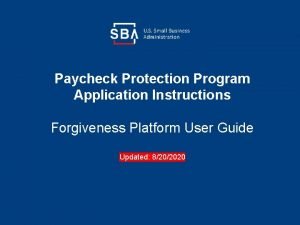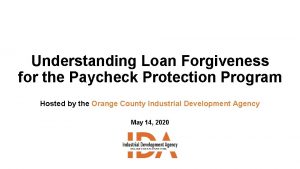Paycheck Protection Program PPP Loans Certifying Need and


































- Slides: 34

Paycheck Protection Program (PPP) Loans – Certifying Need and Determining Forgiveness Bruce Blasnik, Partner Bryan Decker, Partner May 18, 2020

Today’s Agenda § PPP Overview § Certification of Need § Determining Forgiveness § Planning Considerations 2

Paycheck Protection Program Overview

The Paycheck Protection Program § Title 1 of the Coronavirus Aid, Relief, and Economic Security Act or the CARES Act (the “Act”) § Provides forgivable loans equal to 2. 5 months of average 2019 payroll costs, with a maximum of $10 million per entity and $20 million per affiliated group § Meant for small businesses, 501(c)(3) and 501(c)(19) organizations with 500 or fewer employees § Loan proceeds can be used for qualified payroll costs, loan interest, rent and utilities § Amounts not forgiven are repayable over 2 -years, with interest of 1% and a 6 -month payment deferral § $660 billion authorized in 2 tranches of funding 4

The Paycheck Protection Program (Continued) § Administered by the U. S. Small Business Administration (SBA) § Loans processed and disbursed by banks and other lenders § Not a new program – The Act temporarily amended the existing SBA Business Loan Program under Section 7(a) of the Small Business Act • Relaxed underwriting requirements • Expanded eligibility § Division A, Title I of the Act is entitled Keeping American Workers Paid and Employed Act 5

PPP Loans to Date Round 1 Thru 4/16/20 Round 2 Thru 5/10/20 Total Thru 5/10/20 $342, 277, 999, 103 $188, 943, 588, 568 $531, 221, 587, 671 No. of loans 1, 661, 367 2, 571, 167 4, 232, 534 Average loan size $206, 000 $73, 500 $125, 500 4, 975 5, 463 Total loan amount No. lenders § Round 1 was fully committed in 8 days. 6

Certification of Need

Why the Focus Certification of Need § The Act requires every borrower to “make a good faith certification that the uncertainty of current economic conditions makes this loan request necessary to support the ongoing operations of the Applicant” § As round 1 closed, the public became aware of several perceived abuses § April 23 rd – SBA announced that public companies with substantial market value and access to capital markets probably don’t have need § April 28 th – Extended this statement to include private companies with adequate sources of liquidity • Provided a safe harbor for borrowers to return funds by May 7 th 8

Why the Focus Certification of Need (Continued) § April 29 th – Announced all loans over $2 million, plus others, will be audited § May 3 rd – Extended the safe harbor date for returning loan funds to May 14 th and indicated that additional guidance would be forthcoming § May 13, 2020, - any borrower that with its affiliates, received PPP loans amount to less than $2 million will be deemed to have made the certification concerning the need for loan in good faith. § For loans over $2 million, If SBA determines a lack of necessity for the loan, they will not pursue administrative enforcement or referrals to other agencies, if borrower repays the loan. 9

Our Recommendations For entities who received loans over $2 million § Prepare projections going out as long as you believe the pandemic might have an affect on your business § Document the key uncertainties that existed, how you interpreted “necessary, ” what would be detrimental to the business, and other key considerations § Consider the possibility of partial need. § These recommendations are not based on any statutory requirements or definitions. Following these recommendations is not a guarantee that you will avoid issues; ignoring them does not mean you have any issues. 10

PPP Loan Forgiveness

Loan Forgiveness Calculation Eligible Costs Incurred X Employee Retention Ratio (FTEs) Forgiveness Before XS Wage Reduction Less: Excess Wage Reduction Amount Less: EIDL Grant Loan Forgiveness Amount 12

Loan Forgiveness – Eligible Amount § Costs incurred and payments made on the following during the 8 -week forgiveness period (the Covered Period): • Payroll costs • Payments of interest on mortgage indebtedness outstanding prior to February 15, 2020 • Payments of rent and utilities § At least 75% must be expended on payroll costs. Note for nonprofits and businesses with Federal grants: The Act does not address how loan forgiveness will be impacted by the receipt of other government funds – such as federal cost reimbursement grants– that cover some or all payroll and other costs. It is possible that these payroll and other costs will not be eligible forgiveness, and any such loan proceeds received in respect of these costs will need to be immediately repaid. Similar issues may exist with State grants. 13

Loan Forgiveness – Payroll Costs These are the same costs that were used in determining payroll costs for purposes of the PPP loan application: § Salaries and similar compensation of employees, not to exceed $100, 000 a year ($1, 923 a week) for any individual employee § Payments for vacation, parental, family, medical or sick leave § Group health insurance for employees (employer’s cost only) (not life, disability or other insurance) § Retirement benefits for employees (employer’s cost only) § State and local taxes on employee wages (SUI, MTA, but not DBL or WC) § Self-employment income of a sole proprietor or partner, not to exceed $15, 385 for the 8 -weeks 14

Loan Forgiveness – Payroll Costs § Eligible payroll costs must be either • Incurred or paid during the 56 day Covered Period or Alternative Payroll Covered Period • Alternative Payroll Covered Period – For purposes of payroll only; the 8 -week (56 -day) begins on the first day of the first payroll following the Loan Disbursement Date. • Incurred on day the employee’s pay is earned. Costs incurred but not paid during the covered period are eligible forgiveness if paid on or before the next regular payroll date § Salaries of owners (and presumably their immediate family members) cannot exceed actual 2019 compensation, pro-rated to the 8 -week period, capped at $15, 385 15

Loan Forgiveness – Other Costs The following costs paid during the Covered Period or incurred during the Covered period and paid on or before the next billing date § Interest (not principal) on mortgage loans on real or personal property that were in place prior to 2/15/20 • Cannot be prepaid • What is a loan secured by personal property eligible? § Rent for real and personal property obligated under a leasing agreement in force before 2/15/20 § Utilities for services in place prior to 2/15/20 – electricity, gas, water, telephone, internet access, transportation • Cell phones? Trash collection? Fuel for transportation vehicles? 16

Loan Forgiveness – Cash or Accrual? § This still is not clear. Read literally, it could be both… Costs paid or costs incurred during the Covered Period. § For salary costs, seems pretty clear it’s 56 -days using either the cash basis or the accrual basis. § For other payroll costs, the application provides conflicting information: • Page 2 of the Application states to all payroll costs as eligible forgiveness if they were paid or incurred during the Covered Period • The instructions for Schedule A tell us to enter the amounts paid for health insurance, retirement benefits and employer state and local taxes 17

Loan Forgiveness – Cash or Accrual? § For other than payroll costs: • You can include costs accruing at the end of the Covered Period and paid shortly thereafter • But there is no restriction that costs paid during the Covered Period must have also been incurred during the Covered Period § Many questions remain: • Health insurance or office rent – do prepayments count? • What about March & April rent our landlord allowed us to defer? • Or, 2019 profit sharing contribution that has not yet been paid? § For now – Pay expenses in the ordinary course; business as usual. 18

Calculating FTEs § For each employee • The average number of hours paid per week, divided by 40, rounded to nearest tenth • Capped at 1. 0 for each employee • Alternative Simplified method − Assign a 1. 0 for each employee who worked 40 hours or more per week − Assign 0. 5 for employees who worked fewer hours § Your employee retention ratio is the average FTEs in the 8 -week period divided by the average FTEs in either the period: • February 15, 2019 to June 30 , 2019, or • January 1, 2020 to February 29, 2020 19

Calculating FTEs (Continued) § FTE reduction exceptions (you can include these in your FTE count) • Separations − Employees who are fired for cause, − voluntarily resigned, or − voluntarily requested and received reduced hours − can be include in FTE count for the covered period as long as their position was not filled by new employee • If a borrower makes a written offer to rehire a laid-off employee and that employee rejects the offer, that employee can be included in the FTE count in the covered period 20

Calculating FTEs (Continued) § FTE Reduction Safe Harbor: • A borrower is exempt from the reduction in loan forgiveness based on FTE employees if both the following conditions are met − 1) the borrower reduced its FTE employee levels in the period February 15, 2020 through April 26, 2020 − 2) the Borrower then restored its FTE employee levels by not later than June 30, 2020 to its FTE employee levels in the borrower’s pay period that included February 15, 2020 • There is no guidance on how long you have to maintain the restored FTE employee levels. 21

Salary/Hourly Wage Reductions § This only applies to: • Employees who earned an annualized rate of pay of not more than $100, 000 for any pay period in 2019 and • Whose salaries were reduced by more than 25% during the Covered Period (or Alternative Payroll Covered Period) as compared to Q 1 -20 § If this applies, the amount of loan forgiveness is reduced by the amount by which the salary reduction exceeds 25%, unless: • The annual salary (or hourly rate) is restored by June 30, 2020, to the level in place as of February 15, 2020. 22

Salary/Hourly Wage Reductions Example For the Period* Salary for 2019 / Q 1 -2020 Salary for 8 -week forgiveness period Annualized $25, 000 $100, 000 10, 769 70, 000 Reduction amount (30%) 30, 000 Maximum allowable reduction (25%) 25, 000 Excess reduction For the 8 -week period (5, 000/52*8) 5, 000 769 Assume the employee’s salary was not restored by June 30, 2020. * The “Period” is either Q 1 -2020, or the 8 -week forgiveness period, as is applicable. 23

Required Documents to be Submitted § § PPP Loan Forgiveness Calculation Form PPP Schedule A Optional PPP Borrower Demographic Information Form Payroll • Bank account statements or 3 rd party payroll service reports document the amount of cash compensation to employees • Tax forms, 941, state payroll tax returns • Payment receipts, cancelled checks, or account statements documenting the amount of employer contributions to employee health insurance and retirement plans included in the forgiveness amount 24

Required Documents to be Submitted § FTE documentation showing • Average number of FTE employees on payroll per month between 2/15/19 and 6/30/19 • Average number of FTE employees on payroll per month between 1/1/20 and 2/29/20 • Seasonal employer calculation • Must match PPP Schedule A, Line 11 25

Required Documents to be Submitted § Nonpayroll costs • Mortgage interest - Amortization schedule, cancelled checks, account statements for February 2020 and covered period and 1 month after covered period • Lease payments – Copy of lease agreement, cancelled checks, lessor account statements for February 2020, the covered period, and 1 month after the covered period • Utility payments – Copy of invoices from February 2020, those paid during covered period, cancelled checks, and account statements verifying those eligible payments 26

Documents to be Maintained § Documentation supporting the listing of each individual employee in PPP Schedule A worksheet table 1 including applicable documentation of salary/hourly wage reduction calculation § Documentation supporting each employee listed on PPP Schedule A Worksheet Table 2 received during any single pay period in 2019 compensation at an annualized rate of more than $100, 000 § Documentation regarding any employee job offers and refusals, firings for cause, voluntary resignations, and written requests by employee for reduction in work schedule § Documentation supporting the PPP Schedule A worksheet “FTE Reduction Safe Harbor” 27

Documents to be Maintained § All Files must be maintained for six years after the date the loan is forgiven or repaid in full. § Must permit authorized representatives of SBA, including its Office of Inspector General, access to such files upon request. 28

Planning Considerations

Maximizing Forgiveness § Reducing FTEs has the biggest negative impact on loan forgiveness • It is better to reduce salaries than FTEs • If you reduced FTEs between 2/15 and 4/26, plan to rehire them by 6/30 § If non-payroll expenses will fall short of the 25% cap, make sure you are picking up all eligible interest, rent and utility costs § Monitor new guidance as it comes out in order to maximize your health insurance, retirement costs, rent and utilities • Amounts paid for during the Covered Period for costs incurred prior to the Covered Period? • Prepayments? 30

Maximizing Forgiveness (continued) § Consider the appropriateness of paying small hazard pay bonuses to front-line workers § Keep good records, starting now § Don’t do anything out of the ordinary course that might be considered abusive 31

Disclaimer This information and any presentation accompanying it has been prepared by PKF O’Connor Davies, LLP for informational purposes only, and is not intended as and should not be relied upon as legal advice or opinion, or as a substitute for the advice of counsel. You should not rely on, take action on or fail to take action, based on this information. 32

Office Locations www. pkfod. com 665 Fifth Avenue New York, NY 10022 T: 212. 286. 2600 2 Bethesda Metro Center Suite 420 Bethesda, MD 20814 T: 301. 652. 3464 300 Tice Boulevard Suite 315 Woodcliff Lake, NJ 07677 T: 201. 712. 9800 20 Commerce Drive Suite 301 Cranford, NJ 07016 T: 908. 272. 6200 500 Mamaroneck Avenue Suite 301 Harrison, NY 10528 T: 914. 381. 8900 254 Route 17 K Suite 202 Newburgh, NY 12550 T: 845. 567. 3600 293 Eisenhower Pkwy Suite 270 Livingston, NJ 07039 T: 973. 535. 2880 3001 Summer Street 5 th Floor East Stamford, CT 06905 T: 203. 323. 2400 40 Westminster Street Suite 600 Providence, RI 02903 T: 401. 6200 32 Fostertown Rd Newburgh, NY 12550 T: 845. 565. 5400 100 Great Meadow Road Suite 207 Wethersfield, CT 06109 T: 860. 257. 1870 4 Corporate Drive #488 Shelton, CT 06484 T: 203. 929. 3535

Contact Us 34 Ronald F. De. Soiza, CPA, ABV Partner 914. 421. 5604 Bruce Blasnik, CPA, CGMA Partner 203. 705. 4120 rdesoiza@pkfod. com bblasnik@pkfod. com Bryan Decker, CPA Partner 203. 705. 4126 bdecker@pkfod. com Eric P. Gelb, CPA Director of Business Development 914. 341. 7049 egelb@pkfod. com
 Death certification geeky medics
Death certification geeky medics Paycheck
Paycheck Paycheck basics
Paycheck basics How much does wanda earn per hour?
How much does wanda earn per hour? Paycheck
Paycheck 3 benefits of paying taxes
3 benefits of paying taxes Jeopardy
Jeopardy Taly payroll
Taly payroll Chapter 10 personal loans and purchasing decisions
Chapter 10 personal loans and purchasing decisions What is long term loans and advances
What is long term loans and advances Primerica legal protection program phone number
Primerica legal protection program phone number Community air protection program
Community air protection program Witness protection program philippines
Witness protection program philippines Post method era
Post method era Engage study activate lesson plan example
Engage study activate lesson plan example Data link layer in hdlc in computer networks
Data link layer in hdlc in computer networks Student lending analytics
Student lending analytics Pricing business loans
Pricing business loans National student loans ontario
National student loans ontario National loans service
National loans service Inventory loan
Inventory loan Fha 203h loan
Fha 203h loan Manulife rrsp loan
Manulife rrsp loan Alaska postsecondary education
Alaska postsecondary education Section 8-1 single-payment loans answer key
Section 8-1 single-payment loans answer key Pure discount loan formula
Pure discount loan formula List the steps in the paced decision-making process
List the steps in the paced decision-making process Cash mate loans
Cash mate loans Tsahc loan
Tsahc loan Vanderbilt isfaa form
Vanderbilt isfaa form Features of money market
Features of money market Bar study loans
Bar study loans 4-2 loans
4-2 loans Caplines
Caplines Banks extend many fixed-rate loans
Banks extend many fixed-rate loans
